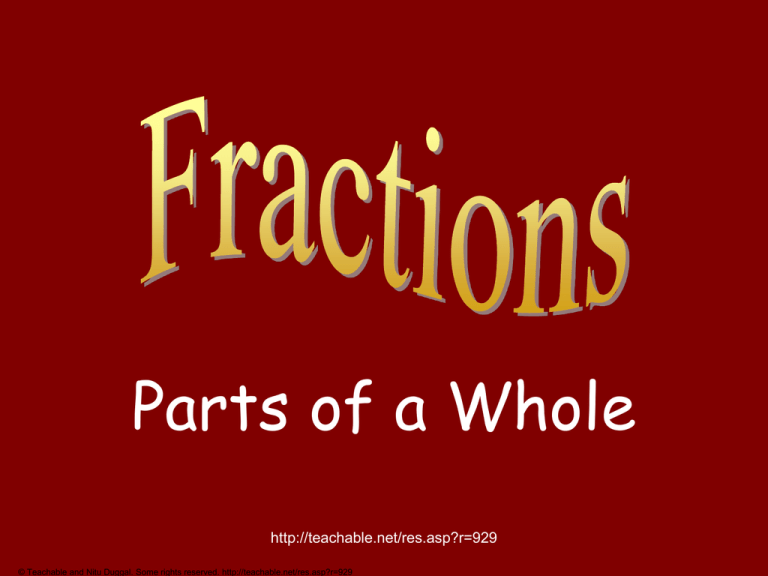
Parts of a Whole
http://teachable.net/res.asp?r=929
© Teachable and Nitu Duggal. Some rights reserved. http://teachable.net/res.asp?r=929
Whole = 1
Two parts of whole
Each part = 1 out of 2
=
© Teachable and Nitu Duggal. Some rights reserved. http://teachable.net/res.asp?r=929
Whole = 1
Two parts of
whole
© Teachable and Nitu Duggal. Some rights reserved. http://teachable.net/res.asp?r=929
Each part
=1 out of 2
=
Whole = 1
Four parts of whole
Each part = 1 out of 4
© Teachable and Nitu Duggal. Some rights reserved. http://teachable.net/res.asp?r=929
=
Whole = 1
Four parts of
whole
© Teachable and Nitu Duggal. Some rights reserved. http://teachable.net/res.asp?r=929
Each part
=1 out of 4
=
Whole = 1
Eight parts of whole
Each part = 1 out of 8
© Teachable and Nitu Duggal. Some rights reserved. http://teachable.net/res.asp?r=929
=
Whole = 1
Eight parts of
whole
Each part
=1 out of 8
=
© Teachable and Nitu Duggal. Some rights reserved. http://teachable.net/res.asp?r=929
A whole can be divided into
any number of parts.
2, 3, 4, 5, 6… 10… 50… 100… 200… any
number!
The golden rule for fractions
is that the parts must be
equal.
© Teachable and Nitu Duggal. Some rights reserved. http://teachable.net/res.asp?r=929
For example:
2 equal parts
3 equal parts
4 equal parts
5 equal
16
equal parts
parts
And so on…
© Teachable and Nitu Duggal. Some rights reserved. http://teachable.net/res.asp?r=929
The total number of equal
parts becomes the bottom
part of the fraction.
It is called the DENOMINATOR
For example:
Denominator = 4
© Teachable and Nitu Duggal. Some rights reserved. http://teachable.net/res.asp?r=929
Denominator = 8
The number of parts that are
referred to becomes the top
part of the fraction.
It is called the NUMERATOR
For example: When we refer to
striped parts
Numerator = 3
© Teachable and Nitu Duggal. Some rights reserved. http://teachable.net/res.asp?r=929
Numerator = 1
So a fraction is written as:
Number of parts referred (NUMERATOR)
Total number of parts of the whole (DENOMINATOR)
For example:
Striped parts =
© Teachable and Nitu Duggal. Some rights reserved. http://teachable.net/res.asp?r=929
Striped parts =
Let’s see more examples
Numerator
Striped part =
Denominator
Numerator
Striped parts =
Denominator
© Teachable and Nitu Duggal. Some rights reserved. http://teachable.net/res.asp?r=929
Numerator
Striped part =
Denominator
Numerator
Striped parts =
Denominator
© Teachable and Nitu Duggal. Some rights reserved. http://teachable.net/res.asp?r=929
Numerator
Striped parts =
Denominator
Numerator
Striped parts =
Denominator
© Teachable and Nitu Duggal. Some rights reserved. http://teachable.net/res.asp?r=929
© Teachable and Nitu Duggal. Some rights reserved. http://teachable.net/res.asp?r=929
•A fraction is part of a whole.
•All parts in a fraction are equal.
•A fraction has a Denominator which is
written in the bottom. It represents the total
number of parts of the whole.
•It has a Numerator which is written on the
top. It represents the number of parts that
are being referred to out of the total parts.
© Teachable and Nitu Duggal. Some rights reserved. http://teachable.net/res.asp?r=929









